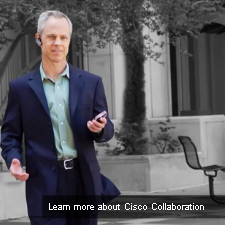Solution architectures are typically derived from open-ended questions designed to discover customer needs. However, Cisco approaches customers with insights-based assertions that rest on the belief that true innovation emerges from disruptive ideas that make customers aware of unknown needs.
According to Gartner’s report “Agenda Overview for P&C and Life insurance 2014,” three concerns for change stand out for insurance companies – profitability and business growth, cost savings, and customer centricity. The study further indicates insurance executives struggle to maintain legacy products while simultaneously addressing concerns and uncertainties of innovation.
This makes innovation sound like a scary proposition, but applying innovation does not have to be scary. It requires a C-suite sponsor who understands the ROI of technology investments and then gives authority to “go-getters” and mobilizers within their organizations to implement these changes. These individuals are motivated by organizational improvement and are constantly looking for good ideas. They mobilize actions around great insights wherever they find them.
At Cisco, we know about innovation and mobilization, as we are constantly building new services while maintaining legacy capabilities. In my first blog, the way we connect with each other has changed, I stated that all carriers have legacy network infrastructures in place today that have the potential to become far more intelligent networks by deploying new collaboration services.
How does this address Gartner’s three business concerns for 2014? Here at Cisco, we help carriers improve processes, reduce costs, and better retain customers via effective collaboration and communication, as a service layer on top of existing carriers’ installed network assets. 
The implication of new service layers enables face-to-face collaboration without place-to-place travel. A benefit of these new service layers is process-driven collaboration that integrates unified communications and collaboration technologies deeply into the carriers’ business processes, such as sales and claims. A day-in-the-life-insurance agency video illustrates how to close business faster by using carriers’ existing network infrastructure, CSR operations, and agents’ BYOD.
One way Cisco delivers deep business insights is through strategic partnerships such as Accenture & Cisco Business Group (ACBG) alliance joint offerings. Accenture and Cisco formed the alliance partnership around Collaboration solutions using unified communications and collaboration technologies that speed up claims approvals by quickly harnessing the input of dispersed decision makers.
The alliance also provides the ability to develop insurance business solutions (i.e. Claims, Distribution and Policy Administration) using unified communications and collaboration elements smartly connected and effectively woven into a carriers business processes. They fundamentally change how the organization does business. By restructuring work around collaboration to execute processes in a way not possible before, the ACBG alliance can help the carrier’s entire organization speed innovation and project delivery, allowing the team to make decisions faster while maintaining a competitive edge, productivity and savings. The ACBG offers “Enhancing collaboration from carrier to customer” by using collaboration solutions that can help organizations achieve measurable results, including:
- Lower operating and capital expenditures
- Decrease travel expenses – by an estimated 20 to 40 percent
- Achieve estimated increases in productivity
- Improve customer service
Alliance partnerships like this help elevate combined companies capabilities that in turn help insurers with insight-based solutions resting on the belief that true innovation emerges from disruptive ideas that reveal unknown needs.

CONNECT WITH US